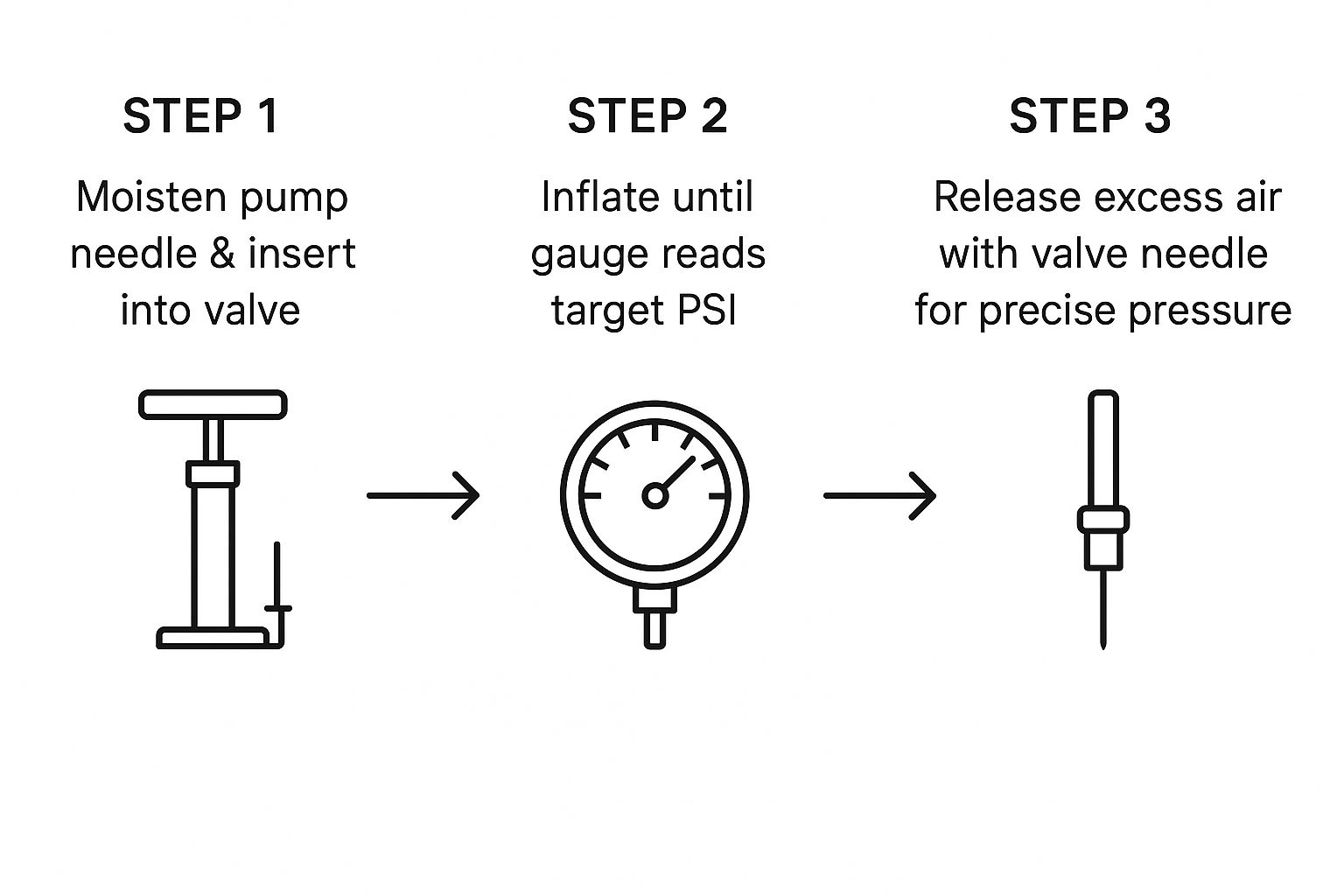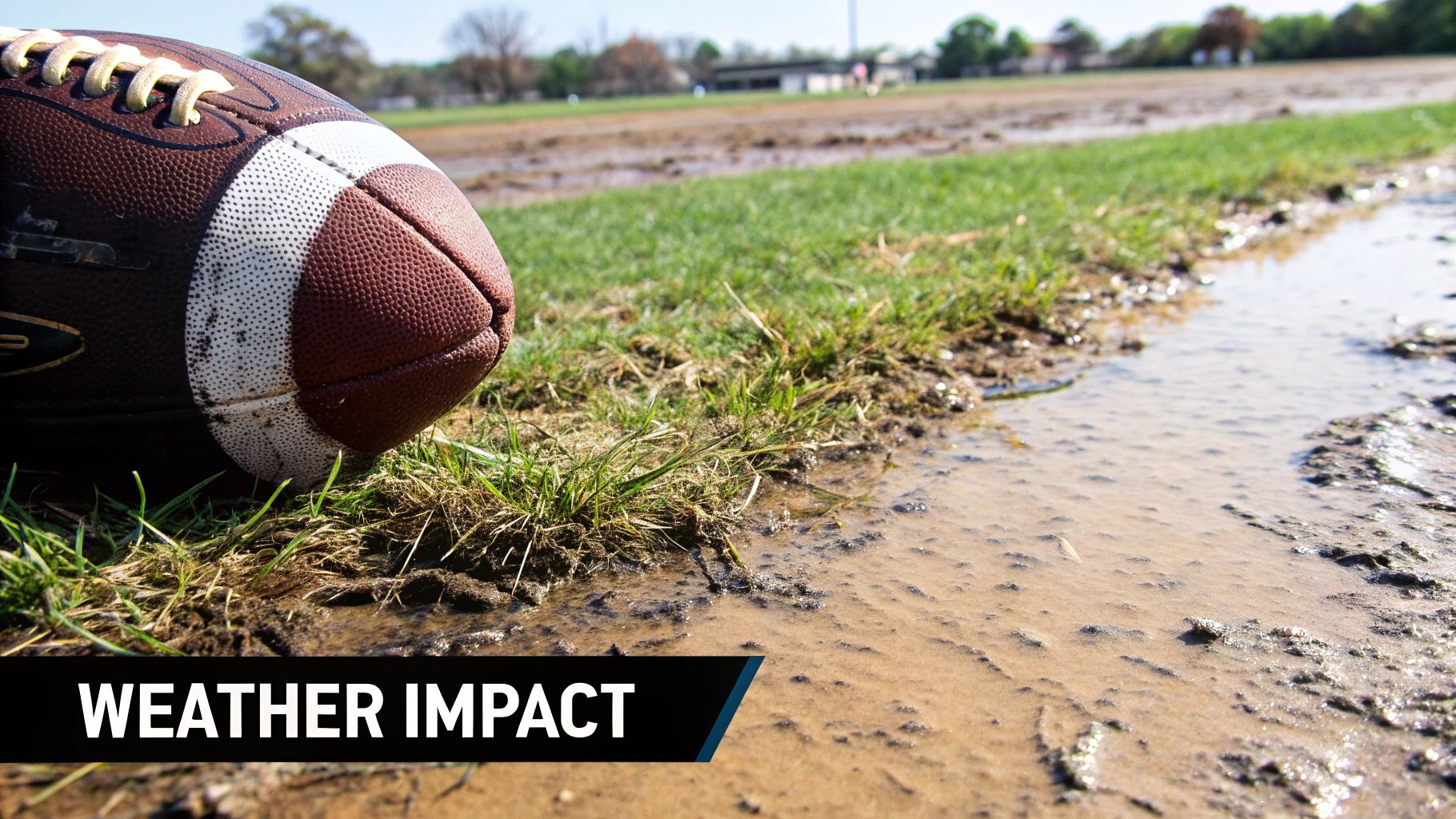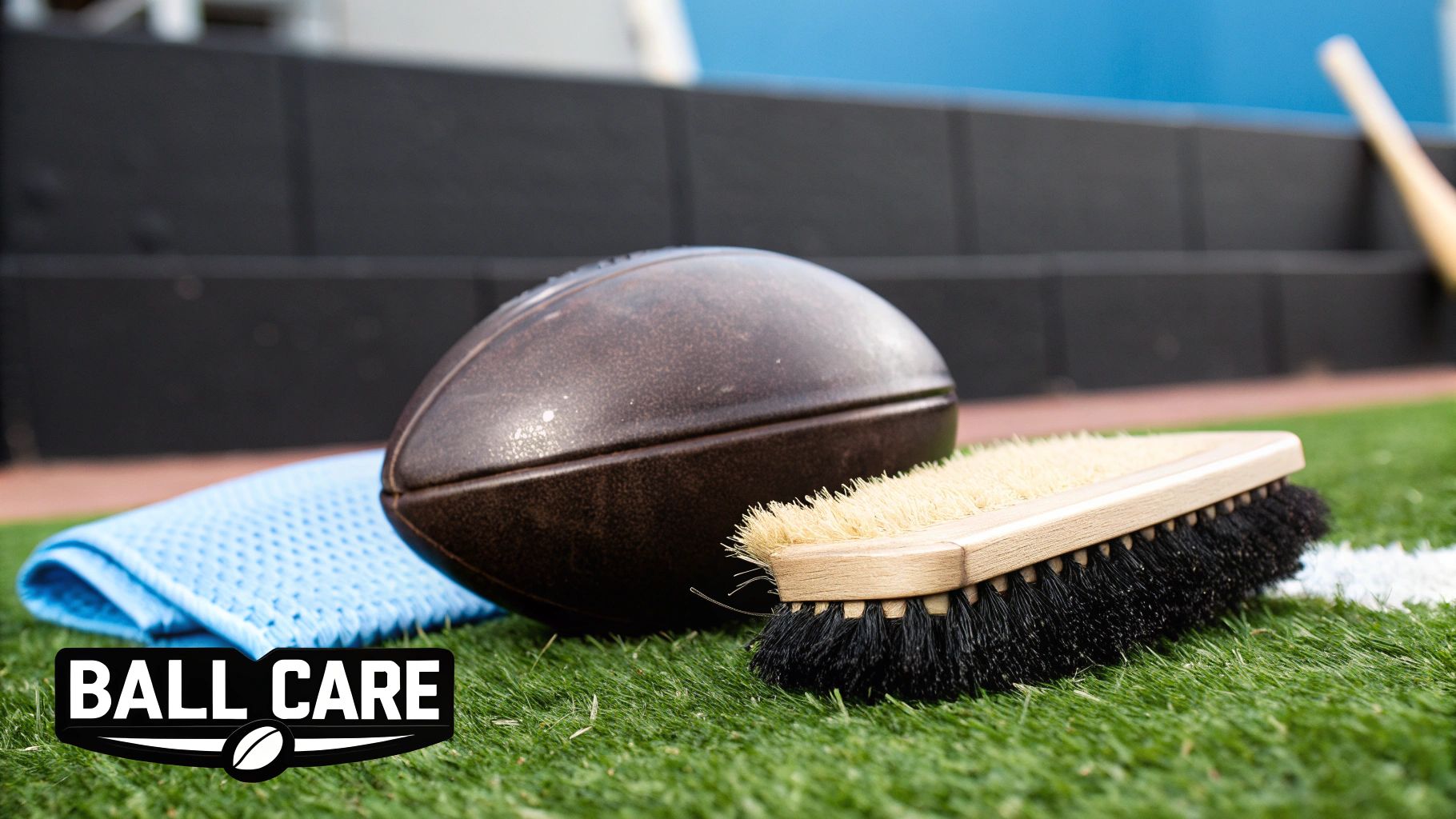Ever wondered why a perfectly struck shot feels… flat? Or why a pass that should have zipped across the turf dies halfway? More often than not, the culprit is the ball's pressure. The correct football pressure psi is one of those small details that makes a massive difference, affecting everything from the ball's flight path to how it feels at your feet.
Why Football Pressure Is a Game Changer

Getting the PSI (pounds per square inch) spot on isn't just about following the rules; it’s about understanding the physics of the game to gain a real advantage on the pitch. The air pressure inside a football determines its hardness, which directly shapes how it behaves when you kick it.
An under-inflated ball feels soft and sluggish. It won't travel as far or as fast, and its bounce is dull and unpredictable. This is the reason for those misplaced passes and shots that lack punch. On the flip side, an over-inflated ball becomes rock-hard and excessively bouncy, making it a nightmare to control. It can feel like kicking a brick, increasing the risk of injury and making a delicate first touch almost impossible.
The Impact on Your Game
When you find that sweet spot, the ball feels both responsive and predictable. This perfect balance is key to several areas of your game:
- Shot Power and Accuracy: A correctly inflated ball compresses just enough on impact before rapidly expanding. This transfers maximum energy from your foot to the ball, resulting in a powerful, true flight.
- Dribbling and Control: The right PSI ensures the ball reacts consistently to every touch, making it much easier to keep it close while running.
- Passing Precision: A predictable bounce and roll are vital for weighting passes correctly, whether you're playing a quick one-two or launching a long ball over the top.
The secret to a great first touch often starts before you even step on the pitch. A ball inflated to the correct PSI provides the perfect canvas for skilful play, rewarding technique with predictable performance.
Setting the Standard for Fair Play
This is exactly why official football bodies have such strict guidelines. In the UK, football pressure has been standardised for decades to guarantee fair and consistent play across all levels of the game.
The Football Association (FA) and the Premier League both require official match balls to be inflated to a pressure between 8.5 psi and 15.6 psi. This regulation has evolved as ball technology has advanced. If you're interested in the history, you can read more about the evolution of English football standards to see how these small details have shaped the modern game.
Finding the Perfect PSI for Your Football
When it comes to preparing your football for a match, there's no single "magic number" for air pressure. The perfect PSI depends on the ball's size and the manufacturer's recommendations for its specific design. Getting that sweet spot right is crucial, whether you're pumping up a standard Size 5 for a weekend league game or a smaller Size 3 for your child's first kickabout.
So, where do you start? The first place to look is right on the ball itself.
Almost every football has the recommended pressure range printed somewhere near the valve. This is your golden rule. It's not just a suggestion; it’s tailored to that specific ball's materials and construction to ensure it performs exactly as intended. Stick to it, and you'll protect the ball's shape and extend its life.
Why Ball Size Dictates Pressure
One of the most common mistakes is assuming all footballs need the same amount of air. A smaller ball generally needs less pressure than a larger one, for a couple of important reasons.
First, it’s about safety. A rock-hard Size 3 ball hitting a seven-year-old is unpleasant and won't build their confidence. A lower PSI gives smaller balls a softer, more forgiving touch, making it easier for young players to learn control without fearing the impact.
As players grow and move up through the sizes, the recommended PSI increases to handle the power and speed of an older, more developed game. A properly inflated ball at the senior level needs to be firm enough to fly true and respond instantly off the boot.
Remember: The printed PSI range on your ball is the key to unlocking its best performance. It guarantees a consistent bounce, a predictable flight path, and that crisp, responsive feel you want at your feet.
To give you a reliable starting point, here’s a handy table breaking down the typical pressure ranges for the most common ball sizes used in the UK. It’s a great quick-reference guide to make sure you get your football pressure psi right every time.
Recommended Football Pressure by Ball Size
| Ball Size | Typical Age Group | Recommended PSI Range | Recommended BAR Range |
|---|---|---|---|
| Size 5 | Ages 14+ | 8.5 - 15.6 PSI | 0.6 - 1.1 BAR |
| Size 4 | Ages 9-14 | 8.5 - 15.6 PSI | 0.6 - 1.1 BAR |
| Size 3 | Ages 6-9 | 8.5 - 15.6 PSI | 0.6 - 1.1 BAR |
Keep this chart handy, but always remember to check the ball itself for the most accurate numbers. A quick check before you pump can make all the difference on match day.
How to Properly Check and Adjust Ball Pressure
Getting the pressure of a football just right is a hands-on job, but it's simpler than you might think. With the right kit and a little know-how, you can get your ball match-ready every time. All you really need are two things: a reliable pump and a pressure gauge.
Before you start pumping, here's a simple trick that can prevent damage: always moisten the pump needle. A little water or saliva is perfect. A dry needle can tear or damage the valve when you push it in, which can lead to a slow, annoying leak.
The Right Way to Inflate
Once the needle is lubricated, slide it gently and straight into the ball's valve. If you go in at an angle, you risk puncturing the internal bladder, so it pays to take a second to line it up properly. Start pumping steadily and keep a close eye on your pressure gauge.
If you’re inflating a whole bag of balls for training, a manual pump can be quite a workout. For a quicker, more precise job, consider an electric football pump. Most models come with a built-in digital gauge, giving you perfect accuracy without the effort.
This infographic breaks down the core steps to achieving the perfect football pressure.

As you can see, it’s a straightforward process: prepare the needle, pump up to the target PSI on your gauge, and then make small adjustments if needed.
Dealing with an Over-Inflated Ball
It’s easy to get carried away and pump in too much air, leaving the ball hard and unpredictable. Don't worry, it happens to everyone and it's an easy fix. You don't need any special tools to let air out.
To release some pressure, just pop the moistened needle back into the valve without the pump attached. The valve will open and let air escape. Give the ball a gentle squeeze and watch your pressure gauge until you’ve hit that sweet spot within the manufacturer's recommended range.
Over-inflating is a classic mistake, but it's easily sorted. A quick check with your gauge and a gentle release of air will get the ball back to its optimal pressure, ensuring it feels responsive and performs exactly as you want it to on the pitch.
How Weather and Pitch Conditions Affect Your Ball

A football’s performance isn't just about what's inside it; it's also about how it reacts to its environment. Anyone who’s played in the UK knows that the weather and the state of the pitch play a massive part in how a ball behaves.
This is where understanding football pressure psi becomes less about following rules and more about making smart, on-the-fly adjustments.
A ball inflated perfectly to the manufacturer’s guidelines can feel completely different depending on the day. For instance, a ball pumped up to 10 PSI on a hard, sun-baked pitch in August might feel overly bouncy, making it difficult to control. That same ball can feel heavy and dead on a soft, muddy field in December.
Tweaking Your Ball for the Conditions
The secret is to make small adjustments within the recommended pressure range to suit the playing surface. Think of the official PSI range—usually between 8.5 and 15.6 PSI—as your adaptable zone. It's not a single target; it’s a spectrum you can work within to get the best out of your ball.
- For Firm, Dry Pitches: Try lowering the pressure slightly, aiming for the lower end of the recommended range. This softens the ball, reduces its bounce, and makes that first touch a little bit easier to cushion.
- For Soft, Muddy Pitches: You’ll probably want to inflate the ball towards the higher end of its range. A firmer ball travels better across a heavy, waterlogged surface and won't feel so sluggish when you strike it.
Fine-tuning your ball's pressure for the pitch is a game-day adjustment that top players make all the time. It shows a deeper understanding of your equipment and gives you a subtle but significant advantage.
Why British Pitches Are So Demanding
Let's be honest, the unpredictable weather in the UK means pitch conditions can change in an instant. The quality of a grass pitch, especially during winter, can vary wildly with dampness and softness, making consistent ball performance a real challenge.
It’s a massive issue across the country. In fact, a survey by the Sport and Recreation Alliance reported that a staggering 60% of grassroots football leagues had to cancel at least 55 fixtures in a single season, mainly due to waterlogging and mud. You can learn more about the challenges facing grassroots football pitches on their site.
This just highlights how crucial it is to adapt your gear to whatever the conditions throw at you on match day. A quick check of the pressure can make all the difference.
A Few Pointers on Football Care and Maintenance

Getting the inflation right is one thing, but keeping your football in top condition is a whole other ball game. A little bit of care goes a long way in making your ball last, ensuring it feels right at your feet every time you play. These simple habits will protect your investment.
After a muddy match or a wet training session, don't just throw it in the bag. Take a minute to wipe it down with a damp cloth. If you let dirt and grit sit on the surface, it can slowly wear away the outer material and stitching. Once it’s clean, let it air dry naturally – never place it on a radiator or use a hairdryer.
Smart Storage and Handling
Where you keep your football is just as crucial as how you clean it. Extreme hot or cold temperatures are a ball's worst enemy. Heat can warp the bladder, and freezing cold can make the material brittle. The best place for it is indoors, at a normal room temperature, away from direct sunlight or a chilly garage.
Here's a classic mistake: people sitting or standing on their footballs. It might seem harmless, but it puts a massive strain on the seams and can ruin the ball's shape. Once it's warped, it'll never fly true again. Treat it like a proper piece of kit, not a spare stool.
A well-maintained football isn't just about longevity; it's about having a ball you can trust. A few minutes of proper care means it will bounce, fly, and feel exactly how you expect it to.
Part of that care routine should be regular pressure checks. Just like car tyres, footballs lose a bit of air over time. Giving the football pressure psi a quick check before every game or session guarantees you’re playing with a ball that’s ready for action.
If you’re keen to see how the right gear can elevate your practice, have a look at our guide to the best football training balls. You'll quickly realise what a difference quality makes.
Got Questions About Football Pressure? We've Got Answers
Let's clear up some of the common questions that pop up about getting your football's pressure spot on. Think of this as your quick-fire guide for any lingering doubts.
What Happens If a Football Is Over or Under-Inflated?
An over-inflated ball is a nightmare to control. It feels like kicking a brick, bounces erratically, and makes your first touch a complete lottery. Worse, you can strain a muscle when you strike it properly.
On the flip side, an under-inflated ball is just as bad. It feels heavy and unresponsive, won't travel as far or as fast, and its bounce is poor. Plus, playing with it can damage the stitching and ruin the ball's shape over time. Getting the football pressure psi right is all about hitting that sweet spot in the middle.
How Often Should I Check My Football's Pressure?
Ideally, before every time you play. Whether it's a big match or just a kickabout in the park, it’s a good habit to get into. All footballs lose a small amount of air over time through the valve.
A quick check with a pressure gauge takes seconds but makes a world of difference to how the ball feels and performs on the pitch.
Can I Use a Bike Pump to Inflate My Football?
Technically, you can, but only if you have the right needle adapter. Even then, it's not recommended. Most bike pumps don't have a built-in pressure gauge, so you're just guessing.
A simple squeeze test is never accurate enough. Your best bet is always a proper football pump with a gauge. It’s the only way to know for sure you’ve hit the exact PSI needed for the best performance.
The right tool for the job makes all the difference. Guessing your ball's pressure is like playing in the dark—you might get it right occasionally, but you'll never have consistency. A proper pump with a gauge is a small investment that pays off every time you play.
Does Temperature Affect My Football's Pressure?
Yes, absolutely. This is something many people forget. When it gets colder, the air inside the ball contracts, and the PSI will drop. When it's warmer, the air expands, and the PSI goes up.
That's why it's so important to check the pressure right before you start playing, in the environment you'll be in. It ensures you're accounting for any last-minute changes caused by the weather.
At SoccerWares, we believe that the right equipment is fundamental to enjoying the beautiful game. From high-quality training gear to stylish fan apparel, we have everything you need to support your passion. Explore our full collection at https://soccerwares.com.

